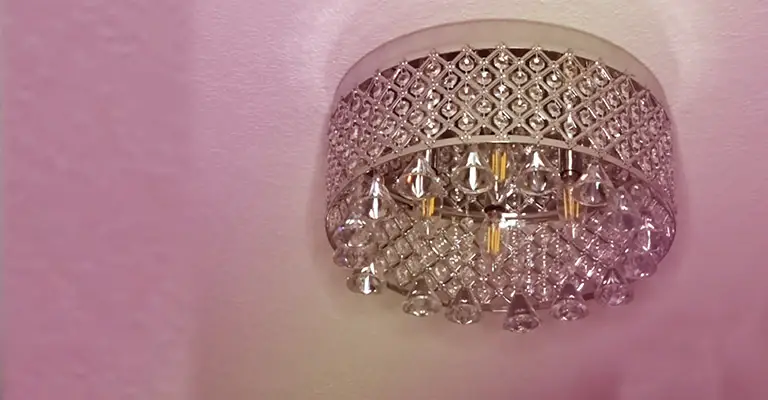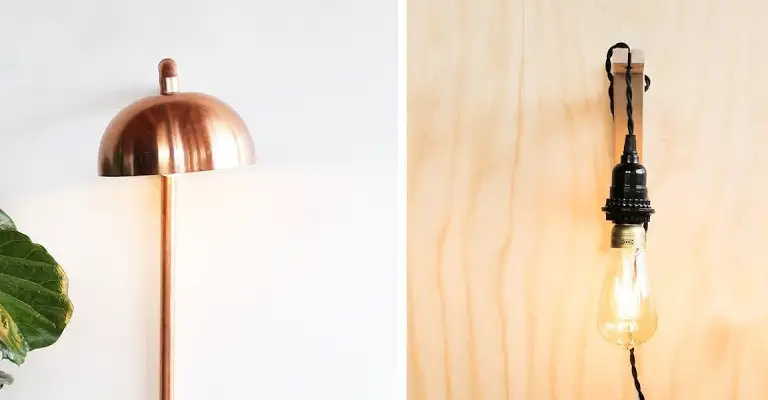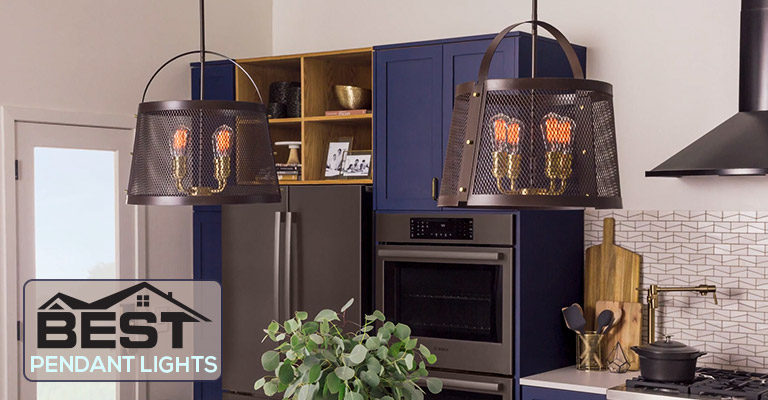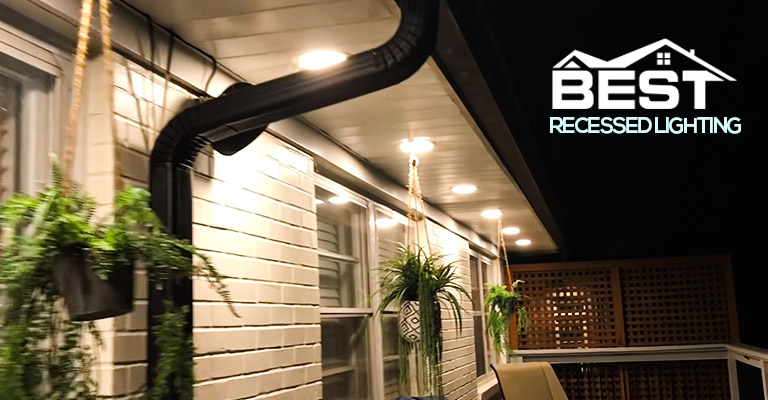How To Turn A Flush Mount Light Into A Pendant?
Even though semi flush mount or even full flush mount lights can be turned into pendants, the process isn’t that easy. The exact construction of the light must be taken into consideration, but I think it’s possible.
Some lights are sold as kits designed for direct mounting on a box or as a chandelier. Generally, lights are made with threaded rods and fittings of standard size. Possibly you can unscrew the ceiling plate and screw on a loop piece after removing the ceiling plate.
Another loop runs through the hole in the original ceiling plate, and then the chandelier chain attaches to that loop. In the electrical box, it is attached to the threaded bracket in the ceiling.
Depending on the fixture, there could be a need for an additional flat or bowl-shaped cover. Rewiring the fixture requires attaching an electrical cord long enough to reach across the chain to replace the wire from the box into the light.
During garage sales, thrift stores and goodwill are probably your cheapest sources of parts. You will likely have to spend almost as much money to obtain your parts from the lighting or hardware store as you would purchase a new fixture.
You will also learn how to adapt your fixture through the process of removing the old fixture. You might want to consider changing your light fixture unless you really love it.
A standard light fixture is much easier to hang, but this job is a bit more difficult. So, make sure to follow these steps carefully.
Turning A Flush Mount Fixture Into A Chandelier
Lighting systems with flush mounts are suitable for rooms with low ceilings. With higher ceilings, chandeliers provide greater light and elegance to the room.
If you are using a flush mount fixture and want to convert it to a chandelier, you will need to remove the old canister and replace it with a new one. The opposite i.e. converting chandelier to flush mount is also possible.
Lights mounted in chandeliers are heavier than light fixtures mounted in flush mounts, so some supports in the ceiling are required.
Things You’ll Need:
- Screwdriver
- Wrench
- Ladder
- Wire pliers
- U-bolt
- Mounting bar
- Fan brace
Removing The Flush Mount Light
Step 1
Turn off the light fixture’s power supply.
Step 2
Remove the screws holding the light cover to the light by using the ladder to reach the flush mount light. You can set the light cover aside.
Step 3
You will need to remove the light bulbs and the screws that hold the ceiling plate to the ceiling. This will allow you to remove the ceiling plate. You will then be able to see the wire canister that is flush-mounted.
Step 4
Pull down the canister gently until you can pull out the wires by removing the screws holding it in place. Put the light kit aside and disconnect the wires from the light kit.
Step 5
Take the wires that feed the light from the electrical junction box and disconnect them. At this point, the canister can be removed and set aside. There will be no need to fix the wiring that hangs from the hole in the ceiling.
Step 6
Remove the screws that held the old ceiling joist or metal bar to the electrical ceiling box containing the wires of the flush mount light.
Installing The Chandelier

Step 1
By spinning the hexagonal bar, you will be able to shorten the fan brace. Set the brace bar inside the hole in the ceiling with its feet flat on the plaster or drywall before moving it up through the hole in the ceiling.
Step 2
By rotating it by hand, make sure every prong in the brace digs into the joist on either side.
Step 3
Make sure the brace is firmly embedded in the joists by tightening it up with a wrench.
Step 4
Using the pre-punched hole in the box, feed the wires through the hole while holding the box near the ceiling.
Attach the wire to the box by feeding approximately 6 inches of wire through it and tightening the screws. The U-bolt included in the fan brace box should be used to fasten the box to the fan brace.
Step 5
Install the chandelier mounting bar in the electrical box by lifting the chandelier. Using the ceiling box, attach the pendant wires to the cables coming from the chandelier.
Put the wires between the canopy and the ceiling, then slide the canopy up. Make sure the canopy fits snugly against the ceiling by hand-tightening it.
Thoughts About Remodeling A Light Fixture
After this project was posted, we completed our kitchen remodel, so we used the instructions to install the new light fixture on the fixture.
This globe pendant light was purchased during the remodel to accommodate our need for more large pendant lights. These work well in this room because of their size. To hang these large pendant lights, we used the same Westinghouse LED converter kit.
For about a year, they have been hanging up without any problem! For the recess openings, I used medallions with the lights, and I love how they look together!
No Need to Touch Existing Wires
There are a lot of old wires in the ceiling of our old house because other light fixtures are inside the ceiling.
In addition, I liked the fact that the extension kit is connected to the original can housing with a socket pigtail, allowing the old wiring to be used with the extension kit. During installation, the kit must be connected to the new fixture and its wiring.
Use Self-piercing Screws
The most common criticism from reviews was the difficulty in getting the screws through the metal edges of the can housing.
Self-piercing screws offer additional security. We used our own self-piercing screws, and the screws easily penetrated the plastic housing.
Make Sure To Use The Right Converter Kit
You will be able to use this Westinghouse recessed light kit with a 6-inch or 4-inch light. Also, this light converter can support chandeliers weighing less than 50 pounds.
This means that you can hang a small pendant as well as a full-sized chandelier! The response to this kit is so positive that I was impressed before I began this project.
Besides the plain white medallion that can be painted any color, another benefit of this converter kit is that it includes a plain white medallion.
Because of our light fixture wall hardware covering the existing ceiling hole, I didn’t use the medallion, but it could be used if necessary.
Final Words
Transforming a flush mount light into a pendant is a brilliant way to give your space a fresh, modern touch. As discussed, the process begins with ensuring the power is off at the circuit breaker to avoid any electrical mishaps. It’s crucial to pay close attention to details, particularly when dealing with the mounting bracket and ground wire. Always remember to turn off the light switch before beginning and, if you’re ever unsure, consulting a professional is wise.
Installation doesn’t have to be daunting. Once you have prepped your workspace, simply install the mounting bracket, ensuring it’s secure. The metal cover plate is not just for aesthetics; it plays a pivotal role in safeguarding the connections. As you transition from the existing can housing of a recessed can light to a pendant, using a kit converter can make the process smoother. This step ensures compatibility and a seamless look between the old and new fixtures.
Finally, the reward for your meticulous work is the installation of new pendant lights, an aesthetic leap from traditional can lights. Not only does this transformation bring a fresh style to your interior, but it also showcases your ability to adapt and innovate existing fixtures. So, the next time you find yourself tired of the same old lighting, remember how simple it is to turn a light into a pendant. With a little patience and the right tools, any space can be rejuvenated.






